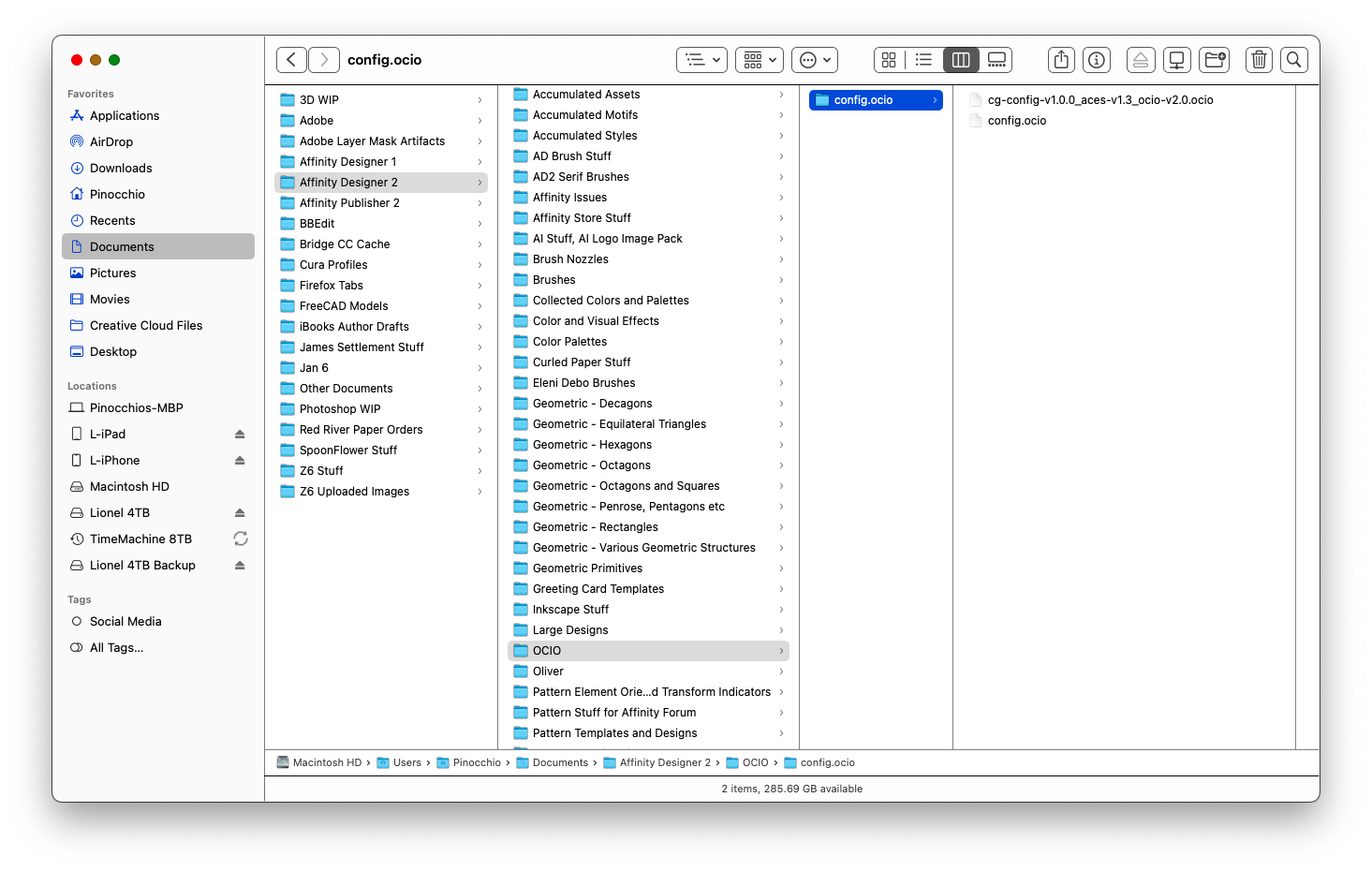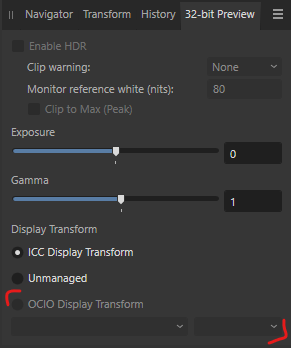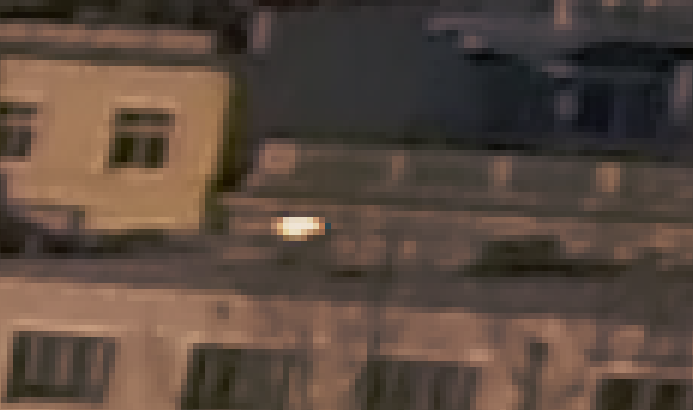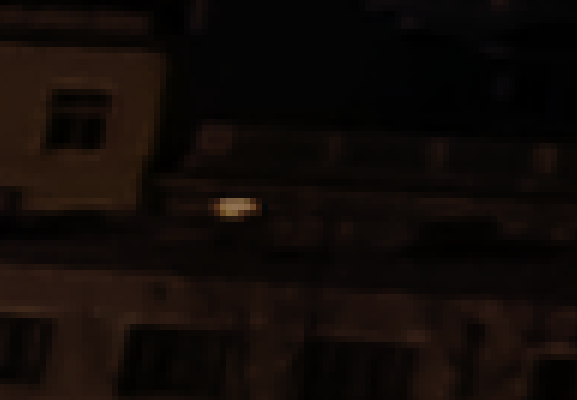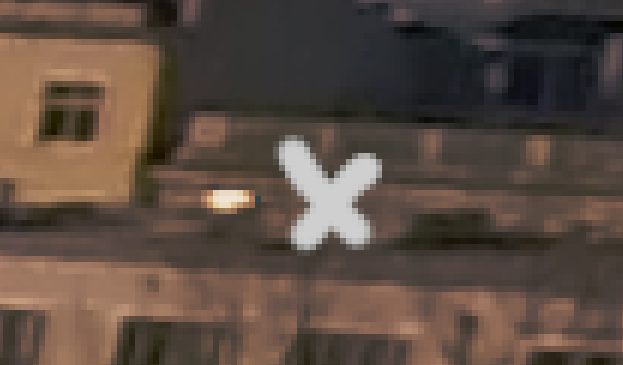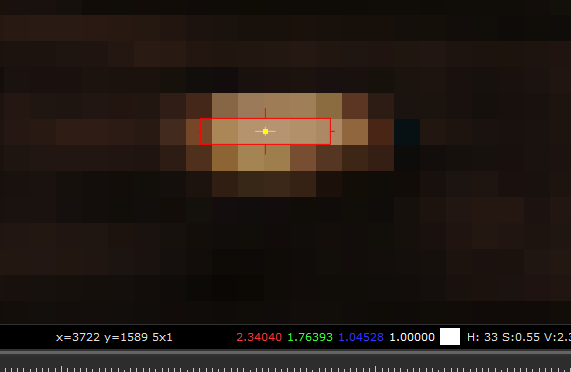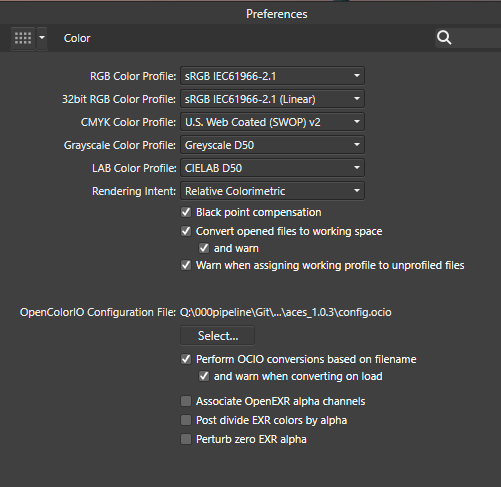Search the Community
Showing results for tags 'ocio'.
-
Hi, this question refers to latest published Designer 2 on MacBook with lates MacOS for my 2016 machine I tried to implement ocio by following the guidance at I almost got there, but now need some help to finalize, please I believe I got the config file downloaded and installed properly because I now have an OCIO adjustment available in the Layers menu, and the 32-bit Preview panel. I tried to test for a successful installation using an existing 16-bit ProPhoto document (I use ProPhoto for all master documents, heritage from photography background) I opened the test document, used Document Setup in Files menu to convert to 32-bit ProPhoto (screenshot 01) I experimented by adding an OCIO adjustment, I get a new layer for the adjustment, the OCIO adjustment panel is completely unresponsive (Screenshot 02). I tried to examine the changes in the 32-Bit Review panel, but the only clickable items are the first 2 in the Display Transform section (ICC Display Transform and Unmanaged - Screenshot 03). The bird changes quite dramatically in response to clicking. Designer Preferences shows the correct path for where I installed the OCIO config (Screenshot 04) Screenshot 05 shows Finder window with ocio config. The config.ocio folder contains 2 copies of the same file - I renamed one, then added a copy with the original name so I have a clue as to what is there... This is my first significant exposure to OCIO, so I'm less than a novice, and I'm sure I have something wrong. Any suggestions will be welcome... Regards
-
Hey, recently I transferred to a new workflow that includes using a different Display Transform (AgX) for my images. Since AgX is compatible with OpenColorIO, I tried setting a destination for an .ocio profile (in the Colour preferences settings) both in Photo and Designer, then restarted the programs to apply the new settings, but **nothing seemed to change**. Later, I tried to do the same with Filmic's ocio, ACES' ocio, different ocio configs (v1.0 & v2.0)... No luck, still no change, all ocio setting are still greyed out. To be more specific, both the OCIO Adjustment layer and the 32-bit Preview windows have all the associated settings greyed out (shown in screenshots), as if there was no ocio config set. I looked around forums looking for a solution, but after hours of research, I have not found a solution, nor haven't encountered someone else having this specific issue. (This is the exact config I am trying to import: https://github.com/sobotka/AgX-S2O3) Any ideas where could be the problem? Thank you!
-
OCIO contextual transform support
dsideb posted a topic in Feedback for Affinity Photo V1 on Desktop
Hi everyone, I was wondering if Affinity Photo was capable of handling OCIO context variables? It's quite common in the film industry to define context-driven colorspace(s) in the OCIO configuration. Either by having a variable part in the search path, or directly in the name of a LUT/CDL file. Theses variables can be then set to different values at runtime and force updating the resources loaded by OCIO processor(s). An example of this being implemented at the user-level is Nuke OCIODisplay and OCIOColorspace nodes that expose a "Context tab" where you can define key-values where the key is the name of variable and value the literal value (e.g. SHOT sc010_0010). This is a quite essential feature for TV shows, feature film etc... I'm happy to elaborate more if needed be. Best, Nicolas. -
Data: Affinity Photo 2 (just installed) - Windows 10 Pro 64 bits Note: this bug has a very simple workaround, but quite cumbersome in repetition if you work with several 32bit images (and OCIO) at the same time. Description of the bug: When working with OCIO in the "32-bit preview" implementation, while having more than 1 image/tab open, the view-transform appears to almost (but not quite) "duplicate" itself at the point of switching tabs. What's happening it's likely that at the point of switching tabs, it's applying the ICC transform + the OCIO one. For example (video attached), I have a Linear-709 image loaded being visualized with an OCIO transform, everything looks fine. I load another one (in this case an identical re-export of the first); the view appears broken. This has a really easy workaround solution: simply switch back and forth the selected transform on the 32-bit Preview panel, and it resets back to looking fine. But as you can see in the video, this step is required every single time you switch tabs/projects. How to replicate: - Load a 32-bit linear image and use OCIO "32-bit Preview" as your preferred visualization method, with any ocio.config of your liking setted up. - Then, load/open another image (also 32 bit, so that it uses the OCIO preview as well). - Switch back and forth between their tabs. If you wish to use the same image I did (its CC0 made by myself, but I tried with other images too with the same bug present): https://github.com/jkierbel/CC-Skull-Test-Image If you wish to use the same OCIO configuration I used for this test (I also tried with other ones with the same bug present): https://github.com/sobotka/filmic-blender/tree/all-views Video showcasing the issue (and it's workaround) attached 20-11-2022-14-29.mp4
-
I have an EXR from blender thats saved in ACES with the official 1.2 ACES package from the github . When I import it into AP, point the configuration file to pathTo/OpenColorIO/aces1.2/config.ocio and in the 32-bit preview window my display settings are set to the following. This gives me the correct image in the viewport which matches my blender render. However, when I go to export the image, the colors are not correct and washed out since I assume this is just a "preview" hence the 32-bit preview tab title and not applying the OCIO display transform to the final image. I tried adding a OCIO adjustment layer but couldnt get anything to work. When I did this I changed the display transform under 32 bit preview to ICC. The input colorspace is ACES-ACEScg since thats what it is and was rendered in in blender. In the Destination color space dropdown I tried a variety of options but none of them worked nor matched the OCIO display transform in the 32 bit preview of sRGB/ACES. The only way I could capture what it is supposed to look like is to either upload the "raw" ACES renders from blender or what i did which was to take a screen snip of the desktop with windows Snip & Sketch. Please help me. I am interested in being able to save ACES only - please dont direct me to look at things related to blender filmic
-
Hey All, Got a question about OCIO and Blender's Filmic profile in AP. I'll preface this by saying I'm no expert in color/gama spaces and profiles, so go easy. Here's my situation. I'm running some tests with 32bit OpenEXR renders out of Blender and compositing them in AP. Up until last week, admittedly, I did this in PS, but PS on the Mac can't open OpenEXR files, and I do like working on my M1-Max. I digress. Back on point... When I open these renders in AP, I get the same exact export output whether I use the ICC Display Transform or OICO Display Transform so long as I have the layer setup as show in the video put out by James Ritson, of Affinity Photo, i.e. OCIO, LUT, OCIO. It's identical on export out to TIFF or JPEG. Can anyone explain what is happening, or what I'm missing... or has AP just been updated since James made his video? Video is linked here. Thank you!
- 2 replies
-
- blender filmic
- ocio
-
(and 1 more)
Tagged with:
-
I was working on a file with a custom OCIO 1.0 config that Redshift made for Blender. I decided that I wanted to change to a un-modified OCIO 1.0 config for ACES 1.2. So I repointed Affinity Photo to that config and restarted the app. Upon opening my file I got a crash. I expected it to need to have my OCIO adjustments changed but, I don't get an opportunity to fix them. I went back to my old config and could open the file. I tried to delete all the adjustments and set the file to unmanaged in the 32-bit preview and saved a copy. But even that copy crashed Affinity Photo if I tried to use the unmodified OCIO 1.0 config. So I had to recreate my file to use another config. We will need a way to fix this sort of problem without having to start over with a new file. I hope you can use this file to build a little more robustness in how it handles moving between OCIO configs so that we can at least get back into files and correct OCIO settings. Fortunately, this was just a test file for me and nothing important. This is with Affinity Photo 1.9.2.1035 This also happens if you have a file set to use OCIO but open it on another computer that does not yet have OCIO configured in preferences. In both cases we should get a descriptive error message and an opportunity to change the OCIO config rather than a hard crash of the app. Without better error handling users would not have any idea how to fix it or assume the file was corrupt. AirwolfPos_Test.afphoto
- 4 replies
-
- ocio
- opencolorio
-
(and 1 more)
Tagged with:
-
I need to run two OCIO config files - a version 1.x and a version 2.x - because some software I use needs one or the other. I have a Windows OCIO environment variable set to the version 2.x config. In AP colour prefs I had originally set a direct file path to the version 1.x OCIO config - as AP requires. However, having subsequently established the Win environment variable to the version 2.x config... AP automatically decided to use that - which fails as you do not yet support v2.x AP is overriding my direct file path entry without my permission and without any option to correct it as the 'Select' button is now grayed out... Actions required: DO NOT automatically override this, or any other, user preference. Allow a manually entered direct OCIO file path, whether or not an OCIO environment variable exists. If no direct file path is entered, and an OCIO environment variable does - then feel free to use it. Just don't override my path!
-
Hi, I recently switched to Affinity Photo from Photoshop. I used to composite my renders as 16bit PNGs in Photoshop. But, since Affinity Photo supports all adjustments and filters in 32bit mode, I started compositing in 32bit using EXR files. However, now the problem is OCIO. The renders from Blender use Filmic color management. As per @James Ritson 's tutorial on baking color space transforms using OCIO adjustment layers, I added two OCIO adjustments -- one from Linear to Filmic sRGB and the second one from sRGB to Linear (with view transform set to ICC in 32bit Preview mode). But, now my question is, where should I add my adjustments (curves, levels, etc.) for compositing? Below or above these two OCIO adjustments? Or should I add them between these two? And also, the problem is, Filmic makes JPEG or PNG layers look very washed out. So, I am currently placing my JPEG or PNG layers (e.g. cutouts) above these two OCIO adjustments and any adjustments that I need to make to my EXR layers, I keep the below these two OCIO adjustments. Am I doing this right? Or is the a different way to do this properly?
- 7 replies
-
- ocio
- blender 3d
-
(and 2 more)
Tagged with:
-
Considering this was my first ever helicopter flight, I think I did Ok. I just held the camera very tightly, without using the screen or viewfinder, just like my stomach and at about 1000 ft pressed the button. I've checked it against Google Earth (Desktop and web versions) and I did a better job than they did. Not bad for my first effort. Santini Air would be proud. Location? Middleton School and Tyesdale, Bretton, Peterborough.
-
- affinity photo
- ocio
-
(and 1 more)
Tagged with:
-
Dear Serif Team and Affinity Photo users, I'm a VFX Compositor & Matte Painter and I'd like to move from PS to AP. I hope you can help me with some questions regarding the Implementation and proper use of ACES and 32-bit. My background plate is exported from Nuke as an ACES - ACES2065-1 16-bit EXR file. The import into AP (1.6.4.104) works fine - the file get's recognized as an ACES file and I get the same result using OCIO. But there are a few things I can't get my head around yet: How do I pick and paint high color values? Using the exposure slider in the 32-bit Preview I see that there are high values. If I pick and paint them back in, the result is way darker. (Changing the exposure doesn't effect the false picked color) picked in Nuke for comparison I moved from PS because there is a 16Bit limitation and I had to work with ACEScc files (log encoded) and use an ICC profile to check my work. I hoped to get around this using AP. Those threads are dealing with the same issue but the information is contradictory and I can't reproduce the method quoted first. https://forum.affinity.serif.com/index.php?/topic/49815-hdr-raw-pixel-values/ https://forum.affinity.serif.com/index.php?/topic/19787--/ What is the proper workflow of importing and edit JPGs in an ACES setup in AP? Unfortunately there's no way of assigning an IDT during import (as in Nuke) but I can reproduce Nukes behavior with OCIO Adjustment Layers, which seams pretty inconvenient. (Windows Photo Viewer as comparison) Bottom left: Two OCIO nodes in sequence [ACES2056-1 to Utility - Curve - sRGB] followed by [Output - sRGB to ACEScg]. Bottom right: Two OCIO nodes in sequence [ACES2056-1 to Utility - Curve - sRGB] followed by [Utility - sRGB - Texture to ACEScg]. This post deals with the question of the right IDT for JPGs in general. I guess going the Utility - sRGB - Texture way is better, isn't it? My color settings: If you need further information or I haven't made my questions clear enough please don't hesitate to ask. I'm glad about any help or further learning resources! Thanks a lot
- 8 replies
-
- exr
- color picker
-
(and 8 more)
Tagged with:
-
Hi, I'm trying follow Affinity official tutorial 'Applying Blender Filmic Looks' (https://affinity.serif.com/en-gb/tutorials/photo/desktop/video/441014543), just to find 'Source' and 'Destinaton Color Space' fields are empty in 'OCIO Adjustement Layer'. I'm on 1.8.5.703 and it worked before, in older version. Don't you know what could possibly went wrong with it? Thank you.
-
Hello, With a custom OCIO config, with 32-bit Linear document in ACEScg color space, with a display management set to OCIO Display Transform and custom display LUT, with several documents open at the same time (all 32-bits ACEScg), we found that the 32-bit display is deactivated when swithing from a document to an other. We have to click on 'Unmanaged' or 'ICC Display Transform' then on 'OCIO Display Transform' to finally see the correct display. Whereas this is not critical, we are always able to bring back the correct display with a few clicks, this is really annoying and perturbing for the artists. This is with Affinity 1.8.3.641 Windows 10. Thanks.
-
After I set up the ocio configuration package, open the 32-bit exr file, and the ipad cannot display the file IMG_0639.MP4
-
The Steps for Making an OCIO Package shown in video do not work under OS10.14.+ The Folder Remains a Folder on iCloud even renamed to ".ocio".
-
Hello, I am starting to re-learn Designer with the arrival of 1.7, and there are a few things that I didn't undertsand first time, with no improvement on understanding with the new version First one is a biggie: What on earth is OpencolorIO. Mind you, I don't work in animated movies and rarely handle LUTs (although it may happen). I checked the help files (didn't help), checked the OpenIO website (Very obscure language), and also this very forum (with a link in one thread refering to explanatory videos - link is broken on Vimeo) I am generally fairly familiar with colour management, but fail to get the concept of OpencolorIO... It's probably that they don't use the same jargon as I am. Can anyone either point me to simpler language references or maybe attempt at explaining themselves? (you can even use puppet socks if all fails ) Thanks so much in advance!
-
After having used the 32-bit modes almost exclusively now since we had them available I noticed some issues with OCIO configurations and maintaining them. What I'm suggesting is a more global config file. I've attached a YAML example. YAML because it's easy to read, duplicate and modify. It can be easily exchanged when working in groups. Download project config from Shotgun, merge with own config and use it right away. Affinity currently has a config switcher that doesn't switch configs. This way it would work and it would be easy for the user to manage. The ICC part is for Affinity to determine which profile is used for converting OCIO data to ICC data for delivery use to devices and services that don't use OCIO (print shops for example). ocio affinity.yaml
-
It's reasonably simple to switch configs in Affinity but it still involves closing everything and restarting the app. You can't have two documents open that need different configs. It'd be great to do the setup of a few configs once and only require a restart when you change that setup. That way we could have open a few documents that are in difference OCIO colour spaces. I often have to switch between nuke-default and ACES nowadays. Being able to set and save (in Affinity format) what config a document used would be great and only like two or three lines of extra meta data. It would also make it easier to work in larger teams and bring work from multiple sources together. Then having an OCIOconfig node/layer which could be used to transform work from one base config to another would be really sweet. Being able to toggle through configs would also be great for last minute jobs where everybody just assumes you know their workflow and eff-off right after emailing you the logins.
-
Hi Affinity team I have two small feature requests that will make Affinity Photo and Designer fit really good into VFX, movie and TVC production. 1. My primary request is import and export in the Open EXR file format. Some of the key features of Open EXR is: High Dynamic range, up to 32 bit float. Multiple channel sets (layers / passes). Multiple compression types, both lossless and lossy. Open EXR is used all around in VFX, movie and TVC production. It is supported by, and the preferred image file format of many tools in VFX production (nuke, maya, modo, mari, fusion, scratch, daVinci resolve, etc. and even AE, but it's really bad implemented in PS). 2. The second request is support for motion picture and TV color spaces. Being able to handle Rec709, cineon (LOG), P3, Rec2020, ACES, etc. correctly in Affinity Photo and Designer would be a huge plus. I'm not a developer, but I think it could be done through the OpenColorIO color management solution, which is also widely adopted by VFX production tools. A still image editor is not the primary tool in the VFX, movie and TVC world. But it is always there as a secondary tool for doing quick fixes, converting images and vector files, developing raw files, etc. These requests I mention are weak points/not supported at all with most other image editors, and I think if Affinity Photo and Designer get's it right, it could be a huge plus, and with the very reasonable price tag I can't see reasons to not choose Affinity Photo and Designer. Cheers /johs





